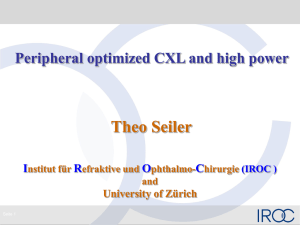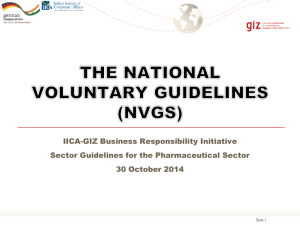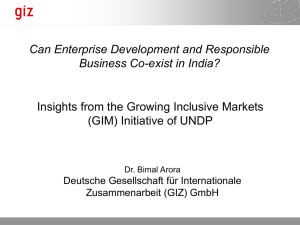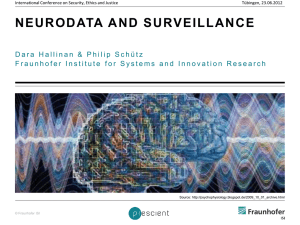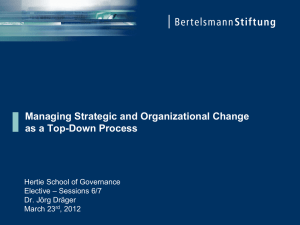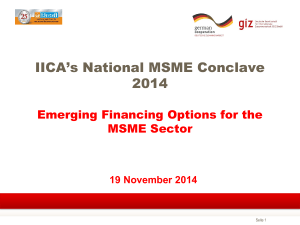here - Cross-border Information
advertisement
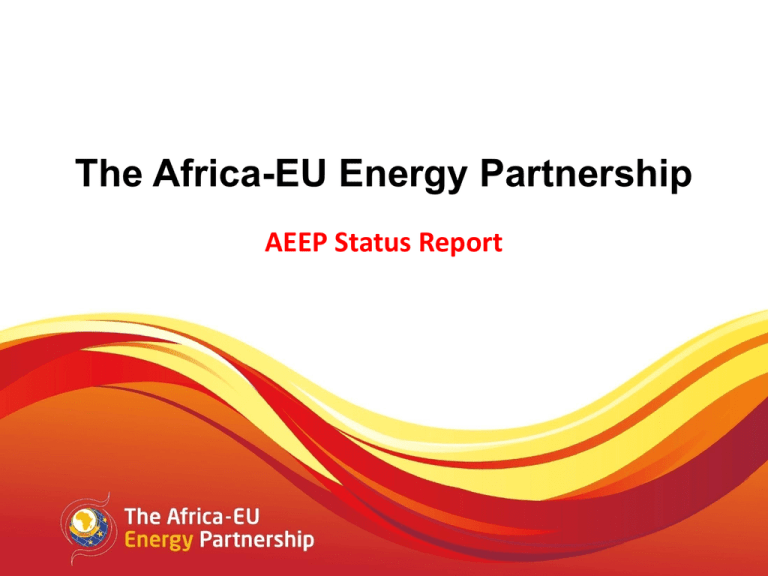
The Africa-EU Energy Partnership AEEP Status Report 08.04.2015 Seite 1 AEEP: A partnership with clear political targets African and European leaders adopted key targets in 2010 covering: I. Energy Access II. Energy Security III. Renewable Energy and Energy Efficiency 08.04.2015 Seite 2 Status Report: Rationale Measuring progress towards common goals Rigorous monitoring of outcomes is needed to ensure effectiveness of joint commitments towards energy sector development in Africa. The Status Report therefore tracks progress towards the AEEP 2020 Targets and aims to inform decision-making in Africa-EU energy cooperation. Not only highlights progress towards political targets, but also identifies areas where more action is needed to achieve our common goals. 08.04.2015 Seite 3 Methodological Approach I The Status Report builds on the “Monitoring Progress under the AEEP” baseline study launched in 2012, during the First AEEP Stakeholder Forum. Based on this study the Status Report operationalizes the AEEP Power Project Database in providing a ground-breaking set of indicators and datasets for the African energy sector. Established project database collates data on all but the smallest projects to help understand how AEEP targets are being reached Database provides a unique tracker for more than 2,700 generation and transmission projects However, availability and reliability of data is subject to severe limitations. 08.04.2015 Seite 4 Methodological Approach II The AEEP Status Report presents the findings of more than two years of data collection and analysis in an easily accessible way, providing the information necessary for moving forward with achieving the AEEP 2020 Targets. All targets in one view Report presents estimates based on different implementation scenarios 08.04.2015 Seite 5 Methodological Approach III Illustrative case studies have been used to highlight key trends: Ghana’s electrification scheme Improved cooking stoves in East Africa Off-grid power set to transform rural Africa Spain-Morocco electricity interconnection East Africa’s cross-border power networks South Africa’s renewables plan Ethiopia’s major hydropower projects Photovoltaic boost for Burkina Faso 08.04.2015 Seite 6 Methodological Limitations Current efforts at comprehensive data collection are constrained Lack of capacity and resource limitations at the level of national statistical offices, but also in international data Data availability and reliability is especially problematic for Energy Access and Energy Efficiency: Extensive analysis by the AEEP Secretariat and its consultants has found deficiencies in all main datasets for access and efficiency. For most other measures, centralised or independent data sets are lacking. There remains a lack of centralised data on African and EU contributions to all but a few measures. 08.04.2015 Seite 7 African Contributions: Budget Allocations 2010-12 There is no central database for African budget allocations to the energy sector. However, AfDB has begun tracking the budgets of 20 countries. The data shows substantial growth in African commitments to the sector, and this is expected to grow further. Between 2010 and 2012 the AfDB‘s 20 countries reported an increase in energy-related budgets of an average 17% per year. 08.04.2015 Seite 8 EU Contributions: Financing Progress on 2020 Targets 08.04.2015 Seite 9 Energy access target Due to significant population growth in many African countries, indicators for access to electricity and clean, sustainable cooking fuels have hardly increased as a proportion of the population. Access to electricity rose to 38.3% in 2010, from 32.8% in 2000. This is the equivalent of 569 million Africans being without access to electricity in 2010. To meet the AEEP target, this number should fall to 490 million by 2020. Access to non-solid cooking fuel rose from 29.3% to 33.2% in 2000-10 – leaving 694m without access. The African population is estimated to rise to 1,261m in 2020 (1,035m in 2010). 08.04.2015 Seite 10 Energy Access Sustainable Energy Access is increasing throughout Africa, but more efforts are needed to achieve the AEEP 2020 Goal. Measuring individual progress in a reliable fashion is difficult in most cases, due to shortfalls in currently available datasets. However available data points towards a slow but steady increase in access. 08.04.2015 Seite 11 Energy Security targets Indicators are generally positive, although results are mixed. Gas consumption within Africa has more than doubled since 2000: Consumption was 122.8bcm in 2012 (107.8bcm in 2010). Recession in Europe and upheaval in North Africa have reduced gas exports to Europe (to levels similar to 2000 in 2012), but this could pick up again (depending on domestic demand and other issues). Total exports fell to 61.7bcm in 2012 (78.9bcm in 2010). 08.04.2015 Seite 12 Energy Security Cross-border electricity transfer capacity has been increasing. Big projects in the pipeline should improve performance. With improved project delivery the AEEP target (doubling interconnection capacity by 2020) could be met. 08.04.2015 Seite 13 Renewable generation target Renewable generation capacity has been increasing steadily. Substantial increase is expected as initiatives such as the South African and Moroccan independent power programmes begin operating. Large hydroelectric projects, scheduled to be commissioned before 2020, will increase the chances of the AEEP renewable energy targets being met. European entities are heavily involved in delivering on these developments. 08.04.2015 Seite 14 Hydroelectric power Installed capacity increased to 27,546MW in 2012 (26,762MW in 2010) At this rate HEP will not meet the AEEP target of adding 10GW by 2020. But work is accelerating. The Project Database shows 25,230MW of new capacity scheduled to be installed in the next six years. This suggests that the 2020 Target could be achieved. 08.04.2015 Seite 15 Wind power Capacity has increased to 1,192MW in 2012 (1,080MW in 2010) This rate of increase is not sufficient to meet AEEP targets. But the rate is expected to significantly increase (helped by South African and Moroccan IPP projects, and other schemes). The AEEP target (an additional 5GW) could be met if the 3,490MW scheduled to commission by 2020 is delivered. 08.04.2015 Seite 16 Solar power Capacity reached 123MW in 2012 (77MW in 2010). The AEEP target calls for adding 500MW by 2020. The Power Projects Database suggests the target is achievable, with 3.1GW scheduled to come on line by 2020. 08.04.2015 Seite 17 Other renewable technologies Limited progress since 2010 for biomass, biogas and geothermal projects: 6MW added to the grid between 2010 and 2012. Huge potential in everything from geothermal and industrial co-generation schemes to using landfill gas. To meet the AEEP target of tripling other renewables, some 2.2GW must be added between 2010 and 2020, equivalent to 3.3GW total generation. Planned geothermal projects in East Africa totaling 4.57GW, and a pipeline of schemes using other technologies, total at least 4.78GW – suggesting the other renewables target can be reached. 08.04.2015 Seite 18 Energy efficiency This report uses energy intensity – units of energy per unit of GDP – as an indicator of energy efficiency. Energy intensity levels have improved substantially over the past decade: Between 2000 and 2010 average final energy intensity measured at purchasing power parity (PPP) fell by 29%, from 15.5 to 11 MJ/$ 2005 PPP. The report also shows levels of network losses. The report includes a table showing laws in 55 countries, covering categories from losses to building regulations. 08.04.2015 Seite 19 Targets to 2020 and beyond AEEP continuously reviews available data to ascertain which targets best meet the goals of governments and peoples. The EU and its member states are first among equals in helping Africa to meet – and in some cases exceed – the 2020 targets. More specific regional targets might take into account differences in the resource base and demographics across Africa, encouraging a better spread of outcomes. AEEP and partners can promote a continental agenda within the global initiative to improve access over the years to come. Continuous reporting on the status of the sectors covered by the AEEP Political Targets is essential. The Partnership is based on a commitment to empirical rigour, which will best allow decision-makers to formulate and implement policy essential to building a better future. 08.04.2015 Seite 20 In conclusion: progress, but more needs to be done Data suggests Africa can rise above some of the targets adopted by the AEEP in 2010 – such as solar, other renewables and even hydropower. Major renewable power procurement programmes in Morocco and South Africa should make a major contribution to achieving the targets for solar and wind power. A few large dam projects will determine whether the hydroelectric target is met: the push to implement PIDA should make this happen. The access targets could be met. Lack of access remains at unacceptable levels in much of Sub-Saharan Africa, but there are grounds for guarded optimism – especially if larger countries implement policy changes and accelerated grid and off-grid access. Major progress is made on several fronts, but it is not necessarily evenly spread among Africa’s diverse economies and societies. The AEEP sees off-grid solutions, as well as larger projects (some with transnational impacts), as essential to promoting more broadly-based development. 08.04.2015 Seite 21

